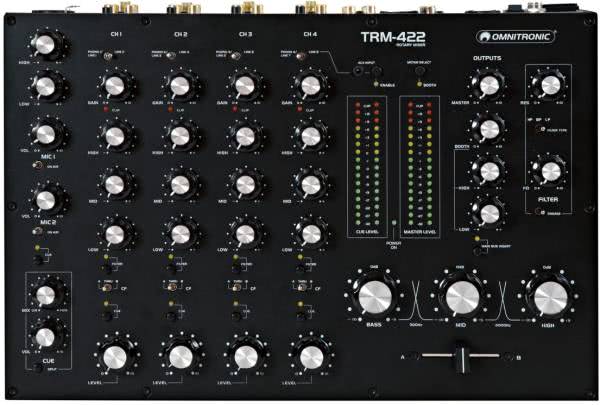Rotary mixers can provide a unique way to perform in the DJ booth. Some of the main benefits of rotary mixers are things like: more precise volume control, sound coloring options with the huge isolator knobs, and usually they emphasize sound quality over extensive functionality - most rotary mixers have pure analogue sound and a vintage, minimalistic design.
The new Omnitronic TRM 422 mixer follows the footprint of the previous successful models, the TRM 202 and TRM 402, with some useful enhancements to please an even wider range of audience. It has the same robust metallic construction just as its predecessors, everything feels sturdy. The Blue Velvet RK27 potentiometers are on point, they feel very solid and have a nice vintage aspect. Everything on this mixer feels like it is built to last.
The TRM 422 is currently the biggest mixer in Omnitronics rotary mixer range. One of the few complaints about the TRM 202 and TRM 402 was that they offered limited options for sound shaping while mixing, with only a 2 band EQ on each channel and the isolator knobs. The TRM 422 addresses this not only with a 3 band kill-cut EQ on each of the 4 channels, but also a filter section with high pass, band pass, low pass, resonance and sweep control for creative mixing. There comes a caveat though, it works in a similar way as it does with Allen&Heath Xone mixers (up to the 96): whenever you turn on the filter on one channel, there is an audible pop, and quite honestly, it is a bit more harsh than its Xone counterparts, but it is not a deal breaker. It will depend on your style of mixing if you will find this annoying or not, but you should be aware of this, if you are on of those who constantly toggles the filter on and off. We can promise though, that once you are using the filter, you will be surprised how clean it sounds, due to its analogue nature.
The sound is exactly the same as on the 402, fully analogue. Don't expect something incredibly pure like on the Rane MP2015, but at this price point we certainly cannot complain about the sound quality. As rotary mainly mixers target the vintage lovers, it is no wonder that it is equipped with good quality phono preamps, as many vinyl DJs will certainly consider buying the TRM 442. The ground terminal on each channel can also confirm this.
Another new feature is the TRIM knob on each channel. On the previous models we had to rely solely on the volume knobs to match the levels on each channel. While the former version certainly had its magic with the more purist approach, we do feel more comfortable with the added TRIM knobs.
Sadly, we still don't get a VU-meter on each channel, but we do get a 16-digit stereo LED level meter, switchable between master and booth outputs, and one for the PFL (CUE) section. It also comes with PFL/master mix control and cue mix/split option. Another wonderful new feature is the 2 band EQ on the booth output, as after many hours of mixing, your ears can certainly suffer from all the high frequencies or from bass distortion, so this way you can adjust this to make it more comfortable.
The lack of the crossfader on the previous models did spike some disappointment from the mixers audience. Luckily, the TRM 422 features a fully assignable VCA crossfader with adjustable curve.
The I/O section is truly rich on this model. It not only offers 4 LINEand4 PHONO inputs, but also 4 direct outputs for TIMECODE applications. The MASTER and BOOTH come with both XLR and RCA outputs, just like on the previous versions. It features 2 FX Send/Return paths: one via RCA SEND/RETURN I/O and one MASTER INSERT I/O for hooking up effects units such as the Pioneer DJ RMX 1000; 2 microphone input channelswith gain control, 2 band EQ and ON AIR switches.

To make it truly vintage, it is 483 mm rack-mountable, mounting brackets are supplied with the unit. You can also shop for some nice matching woodkits at www.omniwoodkit.com to make it more personal and more appealing for your DJ booth.
The TRM 422 can be a fantastic choice for rotary first-timers, as it is unrivalled at this price point; not many mixers can match its pack of features. It is aimed at DJs who simply want to get into rotary mixing and not necessarily blow all their cash on super-expensive models, such as the Condesa, E&S, or Mastersounds - as for these you would have to double or even triple up your budget.
In terms of sound quality, the high-end range does offer more pristine sound, but that is something that you will most likely not notice in your home studio. You won’t get the fancy analogue VU meters, and the wooden borders out of the box, but it is still a wonderful, solid piece of gear, built to last, and comes with a sleek design. It is an absolute bang for the buck if you want to try rotary mixing and don’t want to give up on the additional 2 channels, and all the standard DJ features, like the filter, 3 band EQ, crossfader, and gain control.










